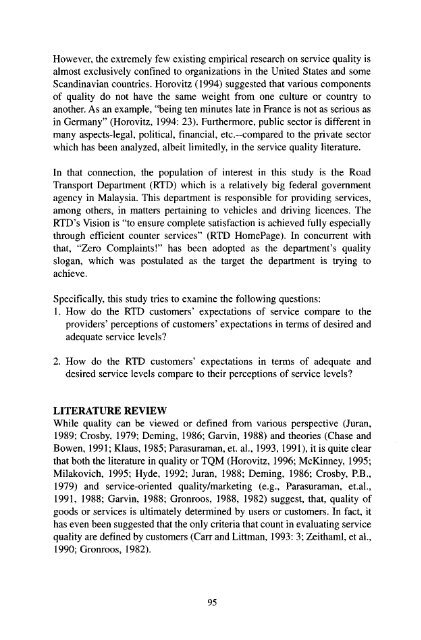(jit) principles and systematic layout planning as tools to improve ...
(jit) principles and systematic layout planning as tools to improve ...
(jit) principles and systematic layout planning as tools to improve ...
Create successful ePaper yourself
Turn your PDF publications into a flip-book with our unique Google optimized e-Paper software.
However, the extremely few existing empirical research on service quality is<br />
almost exclusively confined <strong>to</strong> organizations in the United States <strong>and</strong> some<br />
Sc<strong>and</strong>inavian countries. Horovitz (1994) suggested that various components<br />
of quality do not have the same weight from one culture or country <strong>to</strong><br />
another. As an example, "being ten minutes late in France is not <strong>as</strong> serious <strong>as</strong><br />
in Germany" (Horovitz, 1994: 23). Furthermore, public sec<strong>to</strong>r is different in<br />
many <strong>as</strong>pects-legal, political, financial, etc.—compared <strong>to</strong> the private sec<strong>to</strong>r<br />
which h<strong>as</strong> been analyzed, albeit limitedly, in the service quality literature.<br />
In that connection, the population of interest in this study is the Road<br />
Transport Department (RTD) which is a relatively big federal government<br />
agency in Malaysia. This department is responsible for providing services,<br />
among others, in matters pertaining <strong>to</strong> vehicles <strong>and</strong> driving licences. The<br />
RTD's Vision is "<strong>to</strong> ensure complete satisfaction is achieved fully especially<br />
through efficient counter services" (RTD HomePage). In concurrent with<br />
that, "Zero Complaints!" h<strong>as</strong> been adopted <strong>as</strong> the department's quality<br />
slogan, which w<strong>as</strong> postulated <strong>as</strong> the target the department is trying <strong>to</strong><br />
achieve.<br />
Specifically, this study tries <strong>to</strong> examine the following questions:<br />
1. How do the RTD cus<strong>to</strong>mers' expectations of service compare <strong>to</strong> the<br />
providers' perceptions of cus<strong>to</strong>mers' expectations in terms of desired <strong>and</strong><br />
adequate service levels?<br />
2. How do the RTD cus<strong>to</strong>mers 1 expectations in terms of adequate <strong>and</strong><br />
desired service levels compare <strong>to</strong> their perceptions of service levels?<br />
LITERATURE REVIEW<br />
While quality can be viewed or defined from various perspective (Juran,<br />
1989; Crosby, 1979; Deming, 1986; Garvin, 1988) <strong>and</strong> theories (Ch<strong>as</strong>e <strong>and</strong><br />
Bowen, 1991;Klaus, 1985;Par<strong>as</strong>uraman,et. al., 1993, 1991), it is quite clear<br />
that both the literature in quality or TQM (Horovitz, 1996; McKinney, 1995;<br />
Milakovich, 1995; Hyde, 1992; Juran, 1988; Deming, 1986; Crosby, P.B.,<br />
1979) <strong>and</strong> service-oriented quality/marketing (e.g., Par<strong>as</strong>uraman, et.al.,<br />
1991, 1988; Garvin, 1988; Gronroos, 1988, 1982) suggest, that, quality of<br />
goods or services is ultimately determined by users or cus<strong>to</strong>mers. In fact, it<br />
h<strong>as</strong> even been suggested that the only criteria that count in evaluating service<br />
quality are defined by cus<strong>to</strong>mers (Carr <strong>and</strong> Littman, 1993: 3; Zeithaml, et al.,<br />
1990; Gronroos, 1982).<br />
95


